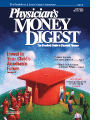Publication
Article
Physician's Money Digest
History Provides Lessons in Investing
Author(s):
They say history repeats itself. Do wetake these history lessons to heartand learn from them? Too often, it's sadto say, we don't.
Bloomberg Personal Finance
One caveat:
In a recent report, Dr. Bryan Taylor, an economist andpresident of Global Financial Data (www.globalfindata.com), examined 100 years ofthe stock market and boiled the datadown to some key lessons for physician-investorsas they move into the investmentworld of the 21st century. Assurely as history repeats itself, the onlycertainty about the stock market is toexpect the unexpected.
CONSIDER GOVERNMENT POLICIES
According to Dr. Taylor, the economiesof Australia, Canada, New Zealand,Norway, and South Africa performed wellin the 1930s, 1940s, and 1970s, when mostother economies were suffering throughbear markets. The reverse has generallybeen true as well. He attributes this phenomenonprimarily to these countries'greater dependence on commodities intheir gross domestic product. This counter-cyclicalnature can help market timersswitch appropriately, and help buy-and-holddiversifiers reduce volatility.
Countries that were stable for most ofthe 20th century, including Australia,Sweden, Switzerland, and the UnitedStates, provided consistent total returnsfor investors employing a buy-and-holdstrategy. This is because when the governmentcreates a stable economic andpolitical environment, corporations successfullyinvest and increase earnings.Where uncertainty and perhaps chaosexist in particular countries, investingabstinence may be the best strategy.
THERE'S NO SURE THING
During the 20th century, most countriessuffered periods of economic and politicalchaos where stock values were almost completelywiped out. Over the past 100 years,the most dramatic bull markets occurred inemerging markets. Similarly, the most dramaticbear markets also occurred in emergingmarkets. For example, Chile's stockmarket increased 60-fold between 1973and 1980, and the Mexican stock marketrose almost 30-fold between 1982 and1987. However, Peru's stock market lost99% of its value between the 1940s and1980s. Hong Kong's Hang Seng Index rose782.8% between 1971 and 1973, and thencollapsed more than 91% just 1 year later.If you're considering emerging markets,remember, timing is everything.
Dr. Taylor points out that the biggestdeclines in real returns almost alwaysoccurred during periods of extreme inflation.He notes that the decade in whichnone of the world's major stock marketsprovided positive real returns was not the1930s, but the years 1910 through 1919,when unexpected inflation brought aboutby World War I surpassed the increase instock market prices worldwide. Inflation,he says, is the subtle destroyer, graduallyeating away at profits built up over time.
IT'S A CONTINUOUS CYCLE
With few exceptions, the world'sstock markets have yet to overcome thebull-bear market cycle. For example, theUS stock market during most of the 20thcentury showed a pattern of 4-year marketcycles, in which a 3-year bull marketwas generally followed by a bear marketof 1 year or less. The exceptions to thelatter part of this pattern in the UnitedStates have been the periods 1929 to1932, 1973 to 1974, and 2000 to 2002. Inaddition, some countries may experienceless destructive bear markets than others,but they all have them.
Dr. Taylor points out that for thoseinvestors who want to live on the edge,certain catastrophic events during the20th century led to the great opportunitiesfor superior returns: Germany in 1923after runaway inflation created economicchaos; Japan in 1946, following the end ofWorld War II; and Mexico in 1984 after thegovernment nearly defaulted on its debt.However, Dr. Taylor cautions, the existenceof the apocalypse is not a sufficient reasonto invest, no matter how daring you are.He suggests that there must also be a signalof fundamental change in the country'spolitical and economic behavior.
Indeed, the 20th century providedlessons that can only help as we move intothe 21st century.
